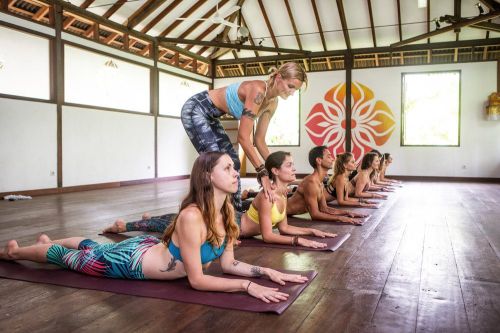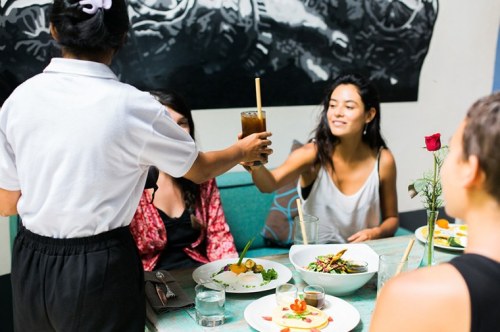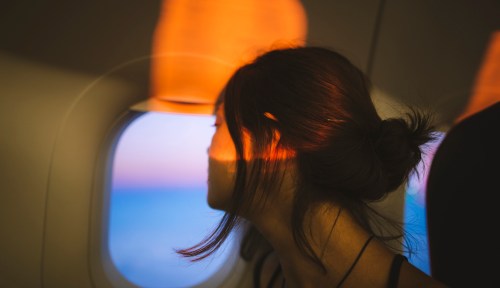A chance to practice in paradise is why the magical, jungle-y Indonesian village of Ubud, Bali has attained bucket-list status among yogis (thousands of which descend upon the nature-ensconced studios every year)—and if you haven’t added it to yours, you should…stat.
“Ubud has quickly become the epicenter for yoga, amazing food, culture, and craftsmanship,” says Denise Payne, an Arizona native who’s lived in Bali for almost seven years. Pronounced ooo-bood, its wellness reputation arguably began with The Yoga Barn, where Payne works. The massive complex, which opened in December 2007, is now comprised of six studios, a guest house, healing center, Ayurvedic massage and treatment spa, outdoor amphitheater, juice bar, and café. “[It’s] like Disney World for yogis,” gushes Khat Matias, a vinyasa and Acro-Yoga teacher who’s based in southern Bali.
The village is an exotic, high-vibe hotspot.
What really makes Ubud the happiest place on earth, however, is its ever-expanding holistic scene—and it’s growing more energetically charged every year. From Balinese bodyworkers to sacred water temples to pretty much every form of healing practice you could want—and plenty you’ve likely never even heard of—the village is an exotic, high-vibe hotspot.
Convinced to book a flight? Here’s everything you need to know about planning a trip to Ubud.

How to get there—and where to stay once you do
All flights into Bali arrive in Denpasar, the island’s capital, a loose hour-and-a-half drive from Ubud. Taxis are available at an airport kiosk (just be sure to use an ATM or change money first), and most hotels will gladly arrange a driver to pick up guests in an SUV (albeit at a slightly higher cost). Traffic is notoriously bad as you near Ubud, so exercise patience and maybe tap into your meditative breathwork on the scenic drive.
Once you arrive, the great thing about Bali is that it’s possible to have a life-changing experience while spending very little money. Yogis and expats love The Onion Collective homestay, and Artini 2 Cottages right in town is a great value, too. For more of a luxe, boutique-y experience, Bisma Eight is your spot. And to hide away in the Zen rainforests and river nearby, opt for the splurge-worthy Four Seasons Resort Bali at Sayan.

Where to practice yoga in Ubud
The Yoga Barn offers 116 classes a week, making it basecamp for most yogis when they’re in town. “I love practicing there because of the world-class teachers—you get exactly what you sign up for,” says Matias. The most popular? “Denise teaches a gnarly power yoga” on Mondays, Wednesdays, and Friday at 9 a.m. followed by an 11 a.m. Yin class, according to the yogi. (It’s known as the Denise Double, notes Payne.) Other styles at the favored hangout include Acro, Iyengar, Vinyasa, Hatha, restorative, plus Tai Chi and things like gong baths, Tibetan bowls, dance, pranayama breathing, and meditation.
Looking for a slightly less prolific place to practice? Take a class at Radiantly Alive, a more intimate studio where Acacia Jade teaches. (Her specialty’s a “playful vinyasa flow that keeps me coming back,” according to Matias.) And aerial yogis will want to check out the studio’s Sky Yoga classes—just plan to “arrive early because we turn people away almost every class,” advises Jade, who also teaches there.
Charley Patton, co-founder of The Yoga Barn, recommends Balinese instructor Warta’s ambitious afternoon classes at Ubud Yoga House, morning Ashtanga sessions at Seeds of Life café, or popping into Intuitive Flow, Dragonfly Village, or Ashtanga Yoga Bali Research Center.
And finally, for a yoga room with a serious view, the all-bamboo shala at the Four Seasons juts out over intensely green rice paddies, providing a blissful—and sonically exciting—home for hot stone restorative yoga and AntiGravity classes.

Ubud is a paradise for both yogis and foodies
“Raw, vegan, vegetarian—or not, the list of restaurants in Ubud is endless, and the level of quality and creativity is unparalleled,” says Payne. If you need a place to start, roll up your yoga mat and head straight to Alchemy. Health-food junkies can’t miss it—or more accurately, its raw-food options and vegan desserts.
Sayuri is where Matias gets a waffle à la mode as her “post-vinyasa victory lunch.”(Both Yoga Barn and Radiantly Alive are nearby). Bali Buda is a mainstay that serves its own form of Indonesian soul food, while Kismet, known for its Asian-infusion dishes, will be your go-to for post-savasana smoothies. (Kafe also offers up classic—but ridiculously fresh—fare.)
For amazing architecture with delicious, vibrant, multicultural food—think Middle Eastern, Thai, Indian, Italian—Matias loves Clear Cafe, which has a fire pole in the back that both staff and guests take to get downstairs. The brunch spot in town is The Elephant—it overlooks a valley of rice fields and even allows diners to take a dip in the pool below after their meal (so BYO bikini and towel). And on Saturday mornings, head to Moksa to eat al fresco in its organic permaculture gardens and shop its weekend farmers’ market for fresh produce. “It’s small and so charming,” says Patton.

Take your high-vibe energy healing to the next level in Ubud
Just as there are seemingly endless yoga classes to try in Ubud, the town’s also a magnet for all forms of wellness and healing services. For starters, the Four Seasons’ new Sacred Nap is a game-changing experience—during a session, you’ll swing suspended in a silk hammock as a former Buddhist nun chants and tells the story of Buddha.
And if you really want some R&R, plan to spend time on the tables of the dozens of spas scattered throughout Ubud—massage, reflexology, Reiki, Chinese medicine, it’s all available. Prices for a one-hour rubdown start around $10. (Try Nur Salon’s massage-and-milk-bath combo, you’ll thank me.)
One of the foremost masseuses in all of Ubud is Ngurah Sudana, who offers Esalen-style bodywork at The Yoga Barn. “He’s connected to source and an amazing healer,” says Patton, who strongly advises making an appointment in advance. Chris Skidmore at Radiantly Alive is your craniosacral-therapy guru, according to Jade. And it doesn’t get more woo-woo than Alchemy Holistic; the place is known for its metaphysical offerings, like intuitive diamond readings, emotional release quantum shift, and zone colonics.

There are plenty of sights in Ubud worth stepping off your mat to see
Friendly locals are the best way to make sure you don’t miss any of Ubud’s beyond amazing offerings. “It’s worth asking around about the Balinese healers,” advises Matias. “And there are always events going on like kirtans (song circles), cacao ceremonies, women’s and men’s circles, acro-yoga jams and ecstatic dances.”
Just outside of Ubud are some of the most sacred sites to local Hindus: the water temples at Tirta Empul in Tampaksiring. Arrive early in the morning for meditation and a cycle through each blessed spout, which are each piled with flower offerings. There you can wash your head and face with the holy water streaming out. A bit further afield is Tirta Gangga, a volcanic crater lake and Patton’s pick if you’re looking to actually swim in sacred spring waters.
If you like primates—and don’t mind them getting up close and personal—wander through Ubud’s famous Monkey Forest. Prefer to keep furry creatures at arm’s distance? Embark on an overnight trek with a guide up Mount Batur, an active volcano on the other side of the island—the sunrise views during the dry season (that would be April–October) are postcard-worthy. Several hours of climbing in the dark, under a blanket of stars, puts you in prime position to watch that great ball of fire rise over a volcanic lake in the distance. It’s definitely a sunrise ritual you’ll never forget—even if you forget to snap a selfie in front of it.
Before you book your flight to Bali, check out these 7 rules every healthy traveler should follow and 4 for catching more zzz’s on your long-haul flight.
This story was originally published on June 13, 2017; it was updated on August 24, 2018.
Sign Up for Our Daily Newsletter
Get all the latest in wellness, trends, food, fitness, beauty, and more delivered right to your inbox.
Got it, you've been added to our email list.











